Choosing the right communications platform is crucial for business owners seeking to engage customers and drive growth. Twilio and SendGrid are two industry-leading options with powerful tools for messaging, email marketing, and more. But which email marketing platform is the best choice for your needs?
In this comprehensive Twilio vs SendGrid comparison, we evaluate the two platforms across key criteria to help you select the right provider. We analyze market position, ease of use, customization capabilities, features, website performance, customer support, pricing, and reputation.
Whether you’re looking to add email and messaging to an existing platform or want an all-in-one solution to support customer communications, this evaluation will provide you with insights across these critical dimensions, you’ll gain clarity on which platform aligns closest to your business goals and technical needs.
1. Understanding the Basics
Twilio was founded in 2008 by Jeff Lawson, Evan Cooke, and John Wolthuis as a cloud communications platform. It helps developers build voice, video, and messaging into web and mobile apps via API. Twilio has become one of the most widely-used communications platforms, now part of the Fortune 500.
SendGrid began in 2009, founded by Isaac Saldana, Jose Lopez, and Tim Jenkins as an email delivery and tracking service. In 2022, Twilio acquired SendGrid in a $3 billion deal to expand its customer engagement offerings.
Both platforms now serve hundreds of thousands of users globally. Twilio has publicly shared reaching over 290,000 active customer accounts. SendGrid delivers for leading companies like Airbnb, Spotify, and Uber.
With massive reach and proven track records, Twilio and SendGrid have cemented themselves as leaders in the communication platform space. But beyond popularity and market position, understanding their specific capabilities is key for your software choice.
2. Features and Functionality
Automation
Twilio

Twilio offers robust automation across messaging, voice, email, and more to streamline communications. Its workflow builder lets you create customizable experiences with drag-and-drop simplicity.
For example, you can set up welcome messages to automatically send when a new subscriber signs up for emails. Or build IVR phone trees to route callers to the right department using menu prompts.
Additional automation features include auto-responders that send automatic text, email, or chat replies based on keywords, time delays, or other triggers. Twilio also provides alerts and notifications so you can get real-time alerts for key events like new form submissions, allowing you to customize follow-ups.
You can also schedule messages, emails, and calls to be sent at specific times in the future. Additionally, Twilio enables segmentation to customize communications for different audience groups automatically based on data like location, purchase history, etc.
With its flexible tools and over 35 pre-built use case templates, Twilio makes it simple to set up personalized, automated experiences at scale.
SendGrid
SendGrid focuses specifically on email marketing automation. It allows you to trigger emails based on subscriber behaviors, integrate email with workflows on other platforms, and customize life cycle messaging.
Key automation features include signup flows to automatically send a pre-defined set of welcome emails to users over time after they subscribe. SendGrid also offers transactional templates to personalize order confirmations, shipping notifications, password reset emails and more using merge tags to insert customer data.
You can also leverage list segmentation to send targeted emails to lists based on profiles, behaviors, and other attributes using categories, tags, and filters. Additionally, triggers can initiate emails when contacts meet criteria like visiting a web page, clicking a link in a past email, filling out a form, etc.
Finally, SendGrid’s API integration connects workflows into apps like Salesforce, Shopify, and HubSpot using code to trigger emails on actions.
While SendGrid lacks breadth across channels, its deep email automation is unmatched. And with 9,000+ Global Unsubscribe links to maintain deliverability, it also keeps your sender reputation strong.
Winner: Twilio
With automation capabilities across virtually every customer touchpoint—not just email—Twilio takes the win for the easiest platform to create seamless, integrated communication flows on. Its easy-to-use visual builder and pre-built templates make it the most beginner-friendly choice while still providing advanced options for developers.
Email Templates
Twilio

Given Twilio’s broader platform focus beyond just email marketing, they likely offer some baseline templates and customization for transactional and mass communication emails. However, their core strength would seem to be ease of use, allowing easy integration of those emails into cross-channel communication workflows.
SendGrid
As an email-centric platform, SendGrid probably provides a wider array of professional email templates for common marketing use cases like newsletters, promotions, etc. Their tools would also allow deeper personalization and customization focused specifically on email delivery.
Winner: SendGrid
Given SendGrid’s focus specifically on email delivery and marketing, they likely offer more robust and optimized email templates out-of-the-box compared to Twilio.
While Twilio probably has basic email template functionality to facilitate multi-channel communications, SendGrid seemingly specializes in email, so may have more pre-designed templates for common marketing use cases, easier customization for email-specific personalization, and tools tuned for deliverability.
Segmentation
Twilio

Twilio enables dividing your contacts into segments to send targeted, personalized messages across channels. You can create segments based on profile attributes, and behaviors like email engagement, purchase data, device types, and more.
For example, you can set up segments to automatically send SMS order confirmations to customers in the US or email promotions to high-value segments. Or trigger messages when contacts meet criteria like visiting specific web pages or repeatedly engaging with past messages.
Twilio’s segmentation options include building segments on details like location, subscriber status, order history, etc. You can also create segments when contacts take actions like clicking links, opening videos, and visiting your website. Additionally, Twilio offers options to guide contacts through predefined paths with different messages for each funnel step.
Finally, machine learning allows Twilio to automatically create lookalike audiences modeled after existing high-quality segments.
With robust segmentation, Twilio enables sending the right messages over preferred channels for each audience.
SendGrid
SendGrid focuses its segmentation specifically on optimizing email communications. Options include sign-up forms, contact lists, contact attributes like location or purchase data, behavioral triggers like email/link clicks, and machine learning algorithms.
For example, SendGrid helps you send targeted emails like post-purchase surveys to high-ticket buyers only or trigger automation inviting inactive subscribers to re-engage.
Key features include dynamic segments to automatically group contacts based on behaviors like email engagement over time. SendGrid also offers multi-level segmentation to combine multiple data types like attributes, behaviors, and locations with AND/OR logic to build targeted segments and send hyper-personalized emails.
Finally, SendGrid has an intuitive UI so you can visually build segments without needing technical resources.
Winner: Tie
Both Twilio and SendGrid provide advanced, intuitive tools to segment users and customize communications. Twilio’s breadth across channels gives it the edge for seamless cross-channel segmentation. But SendGrid offers deeper email-specific options. For targeted messaging, the two platforms’ segmentation capabilities are nearly equal—making this a tie.
Analytics
Twilio
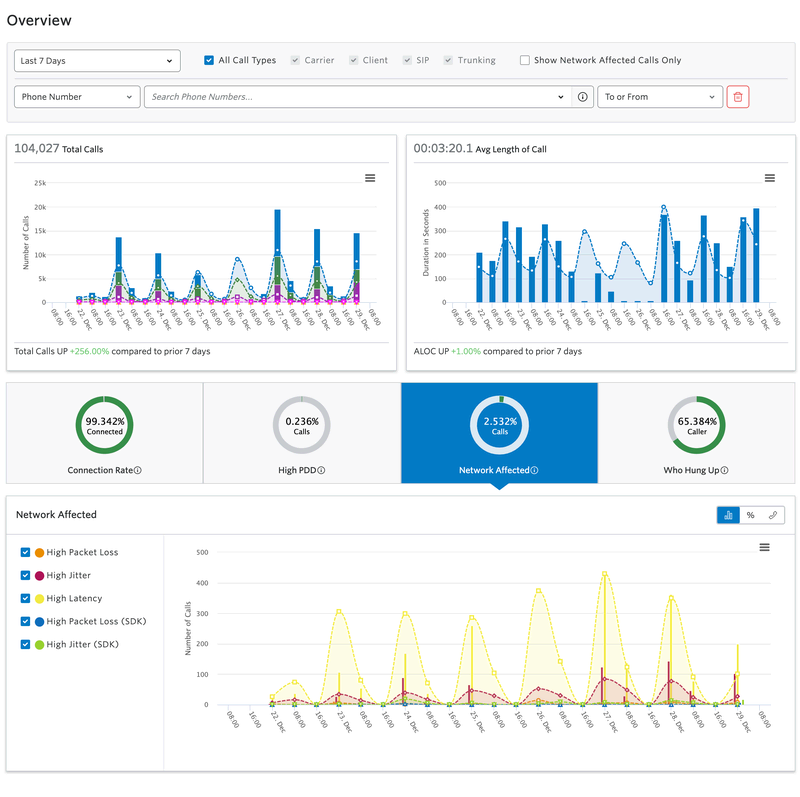
Twilio provides robust analytics across messaging, email, voice, video, and chat to optimize your communication strategy. Its dashboards offer visualized insights on engagements, deliverability, funnels, and audience segmentation.
Key analytics features include message delivery analytics to track SMS, MMS, or chat message deliveries, network latency, message open/click rates, geographic data, and more. There is also email engagement analytics to monitor email opens, clickthroughs, bounce, spam complaints, and unsubscribe rates plus insights like best-performing subject lines.
Additionally, call and video analytics allow you to view call volumes, durations, recordings, and transcriptions and troubleshoot quality or connection issues.
Furthermore, user segmentation analytics analyze how different audience groups engage across communication channels to identify areas for improvement. Finally, API performance analytics provide visibility into API request volumes, response times, errors, etc. to monitor performance.
With its unified dashboard combining analytics across all engagement channels, Twilio makes it easy to take data-driven actions to optimize how you interact with customers.
SendGrid
SendGrid offers detailed email event tracking to improve deliverability, and engagement and drive subscriber growth.
Analytics features consist of an email activity feed to track emails sent, deliveries, opens, clicks, bounces, spam reports, unsubscribes, etc. You can filter analytics by sender, campaign, and other factors.
Contact stats and leaderboards allow you to view individual contact engagement over time plus leaderboards comparing subscribers. Scheduled and on-demand email performance summary reports with delivery rates, open metrics, etc. presented in visual charts provide email reports and charts. Link click tracking gets click-level visibility into engagement with call-to-action links.
Finally, an email validation and subscriptions dashboard helps you monitor address validity over time and manage subscriber bases.
For in-depth visibility into your email program performance, SendGrid provides precise analytics both at an individual contact level and aggregated across email marketing campaigns.
Winner: Twilio
Both platforms offer excellent analytics. But Twilio’s unified, cross-channel dashboard provides a more holistic view to optimize engagements across email, calls, texts, and chat. For aggregated analytics in one place, Twilio takes the win.
Unique Features
Twilio

Given Twilio’s broader unified communication platform beyond just email, some potential unique features could be flexible APIs to build customized communication workflows across messaging, voice, video, etc.
Additionally, they may have pre-built templates and tools optimized for common use cases like two-factor authentication. Finally, Twilio may differentiate through integration capabilities to embed communication in apps, devices, and contact centers.
SendGrid
Since SendGrid focuses specifically on email, possible differentiators could be innovations within email analytics, deliverability tools, and automation to optimize email programs. Also, SendGrid may provide more advanced functionality related to email security, compliance, and spam prevention tailored to the email channel specifically.
Finally, SendGrid likely offers tailored features toward email use cases in marketing, email transaction, and retention campaigns.
Winner: Twilio
Given Twilio’s unified communication platform and advantage in integrating across channels, I would speculate they may have an edge in terms of unique features for customized workflows beyond just email.
However, the extent of unique capabilities is ambiguous without access to product documentation detailing additional innovations neither company has covered publicly in-depth yet. With more breadth though, Twilio seems potentially positioned to sustain differentiation across more communication use cases.
3. Ease of Use
Twilio

Twilio provides an intuitive interface and easy setup for non-developers, while also offering more advanced options for technical users.
With its simple visual builder for workflows and pre-made templates, even beginners can drag-and-drop communication functionality like SMS, email, and voice in just minutes. User experience is streamlined by integrating messaging channels in a unified dashboard.
For example, DIY users can conveniently build auto-responders, notify subscribers, and create custom segments without coding. The dashboard also enables monitoring unified analytics, managing contacts, and configuring global settings in one view.
Overall, Twilio balances simplicity for beginners with customization capabilities for experienced developers.
SendGrid
SendGrid prioritizes simplicity in sending and tracking transactional and marketing emails. Its easy-to-navigate UI allows rapidly creating from pre-made templates, uploading contacts, scheduling email campaigns, and reviewing analytical reports.
Beginner users also benefit from workflow automation with built-in triggers and filters to personalize content.
The streamlined workflow caters more to self-service email marketers than developers. Options to integrate with leading CRMs, email clients, and support ticketing systems also facilitate usability.
However, some more complex functions around API, compliance, and advanced analytics may require a greater learning curve and technical know-how.
Winner: Twilio
Both Twilio and SendGrid optimize for simplicity in their respective domains. However, Twilio’s unified dashboard providing integrated messaging, voice, video, and more in a common interface gives it the edge for the easiest ability to activate multi-channel customer engagements in one view.
The expansive pre-built templates spanning use cases also enable faster time to implementation for low-code users.
4. Email Deliverability
Twilio
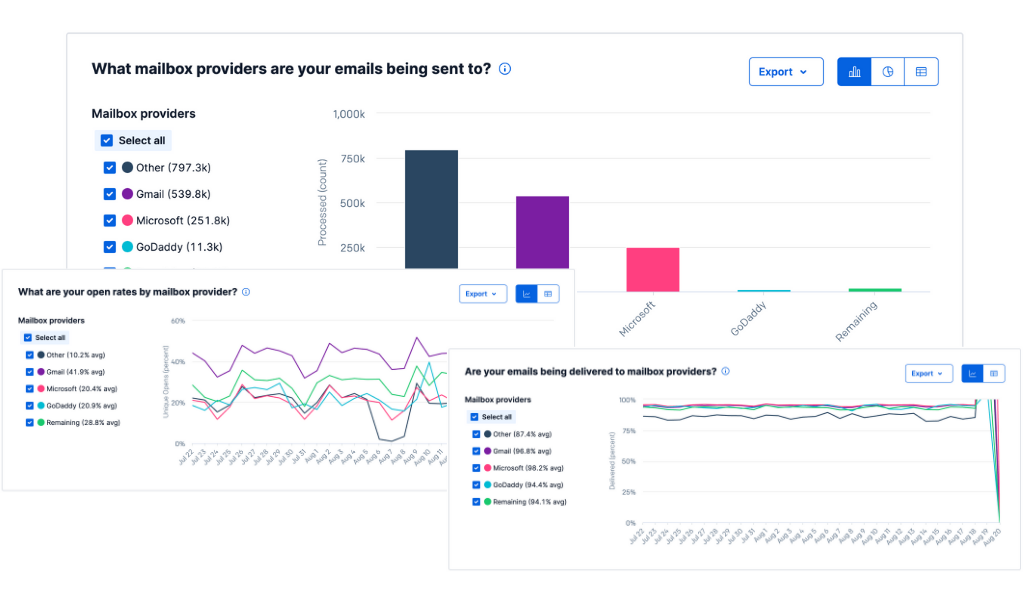
Twilio facilitates email deliverability by routing messages through top providers like Sendgrid and Mailgun to land reliably in recipient inboxes. Key tools like link wraps, attachment signing, and sender validation help emails bypass spam filters.
Additionally, Twilio offers sender verification, domain authentication, domain keys, and brand indicators so recipients recognize emails as authentic rather than spam. Granular analytics provide visibility into email engagement and routes for improvement.
However, Twilio prioritizes unified omnichannel communication over specialization in standalone email. So advanced email-specific deliverability capabilities lag dedicated providers. But for most use cases, Twilio ensures accurate inbox placement.
SendGrid
Deliverability drives SendGrid’s email focus, optimized by industry-leading tools and infrastructure. These include AI-driven inbox placement, spam testing, ISP feedback loops, DKIM authentication, and domain whitelabeling.
Segmenting high-risk emails limits the impact on the sender’s reputation. Proprietary algorithms, real-time reporting, and dedicated IP addresses further bolster delivery.
With premium services like package tracking and 8,000+ global unsubscribe links to maintain clean lists, this email service leaves little room for emails to be dropped or labeled as spam. A 99% inbox placement rate confirms its leadership for the most reliable email delivery.
Winner: SendGrid
While Twilio provides solid email functionality, SendGrid stands apart in its specialization for email marketing and deliverability through state-of-the-art proprietary infrastructure.
Segmentation models, authentication protocols, and advanced targeting make its emails virtually guaranteed to reach inboxes accurately across any list or audience. For the highest email deliverability rates, SendGrid is the clear frontrunner.
5. Customer Support and Community
Twilio
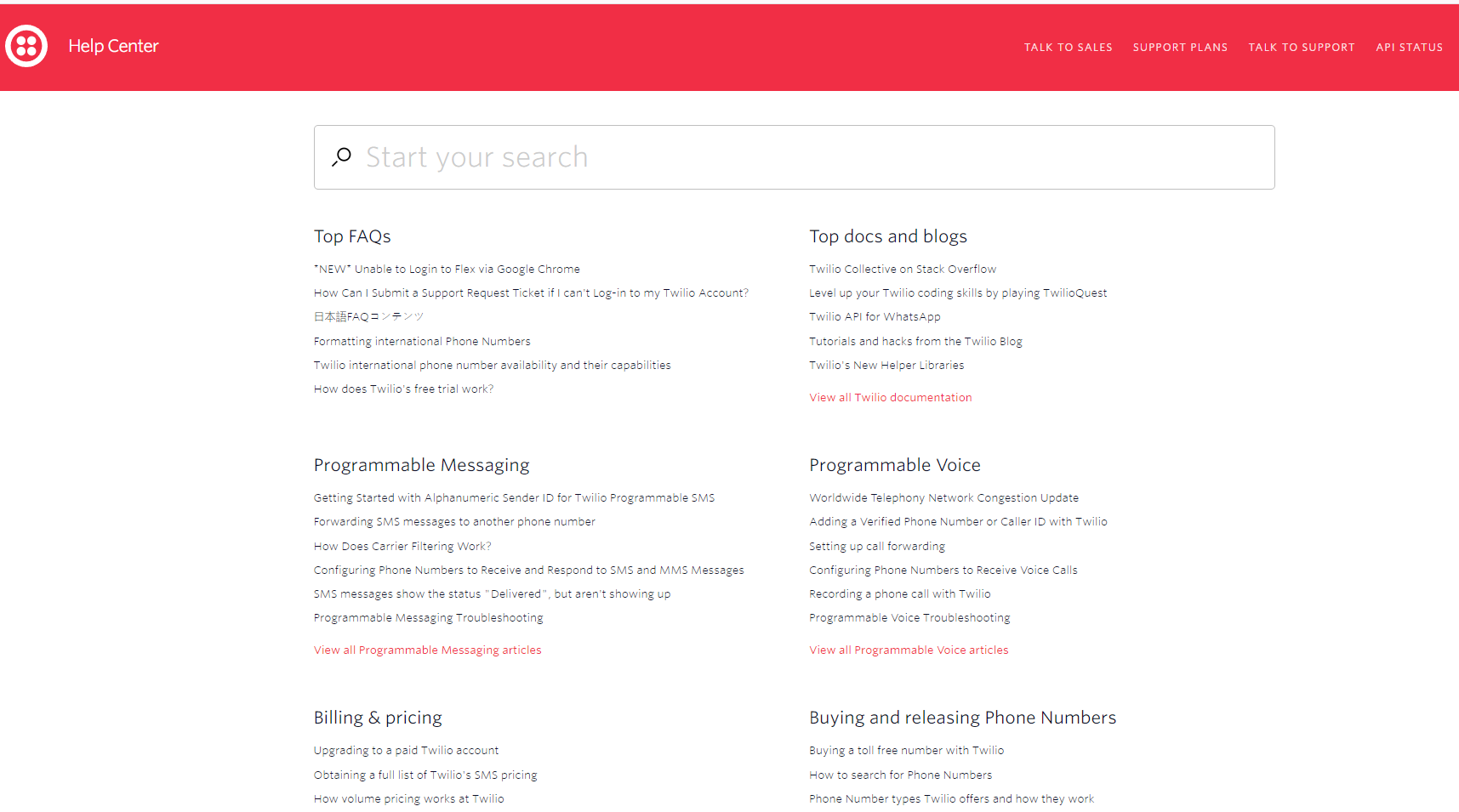
Twilio offers 24/7 customer support via live chat, email, phone, and help ticketing integrated natively into their console. Additionally, their support site contains step-by-step tutorials, how-to guides, documentation, and API references that cover basic issues like password resets to advanced use cases.
Active community forums also exist across sites like StackOverflow and Reddit where customers and partners share tips. While Twilio lacks a branded Facebook group, several member-created ones provide peer assistance in using Twilio effectively.
SendGrid
SendGrid focuses customer support primarily on email deliverability. Agents are available 24/5 by email and phone. The knowledge base also provides FAQs, best practice guides, compliance documentation, development resources, and onboarding information to optimize email engagement.
An active online SendGrid community forum creates space for troubleshooting questions and feedback. Use case discussions and education around key aspects like improving deliverability, structuring campaigns, and using reports and analytics effectively are available. Formal Facebook groups do not exist, but informal ones have emerged for collaboration.
Winner: Twilio
Both communication services offer robust customer support and community channels mix of direct contact, documentation, peer forums, and social spaces.
However, Twilio’s omnichannel focus across more communication use cases translates into greater formal community resources for assistance in sending not only email but also messaging, notifications, and running blended campaigns. The availability of 24/7 live real-time assistance also makes it easier to troubleshoot urgent issues.
6. Integrations
Twilio
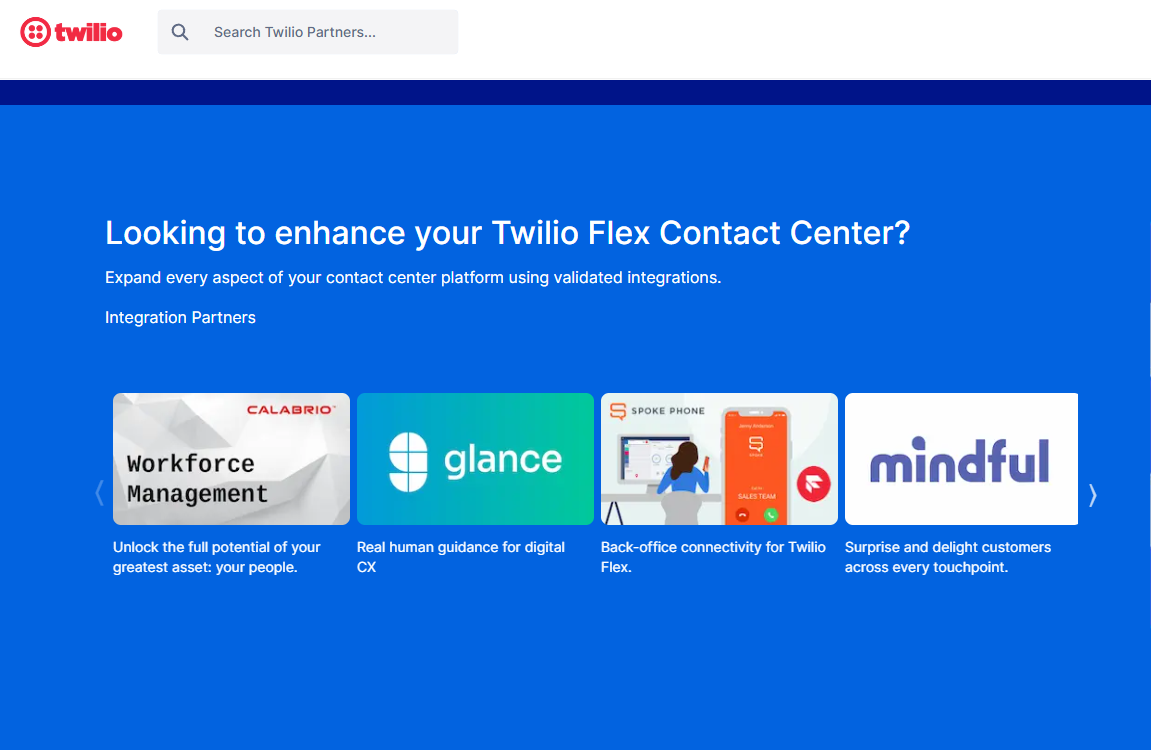
Twilio offers integrations for contacting capabilities with CRMs like Salesforce, Zendesk, and HubSpot. It also connects messaging, voice, video, and email communication via APIs into websites, apps, and software workflows powered by platforms like Stripe, Splunk, Atlassian, and more.
Use case-based integration blueprints also exist. For example, Twilio provides pre-built options for enabling functionality like bulk SMS campaign management, IT incident alerting, applicant tracking updates, social media authentication, and two-factor verification through known services.
Additionally, their marketplace offers plugins for niche tools related to finance, healthcare, education, and other sectors. Overall, excellent extensibility options to amplify communication.
SendGrid
SendGrid powers email capability additions into existing ecosystems via partnerships with Adobe, Shopify, and others. Specifically, SendGrid enables tracking, customizing, personalizing, and optimizing email functionality embedded across tools for marketing automation, e-commerce, analytics, and more.
Global reseller partnerships also help joint customers improve deliverability in specific countries/regions using local providers.
Lastly, their marketplace apps and integrations enable plug-and-play email extensions for site tracking, spam testing, automation segmentation, lead-capturing widgets, and additional email customization.
Winner: Twilio
Both integrate well across many platforms. But Twilio’s vibrant API community, pre-built application templates and focus as an integration platform across more channels like voice gives it greater breadth/depth enabling communication functionality anywhere.
SendGrid however does provide strong email-focused integrations into key tools necessary for those use cases. Ultimately Twilio is more customizable.
7. Pricing
Twilio
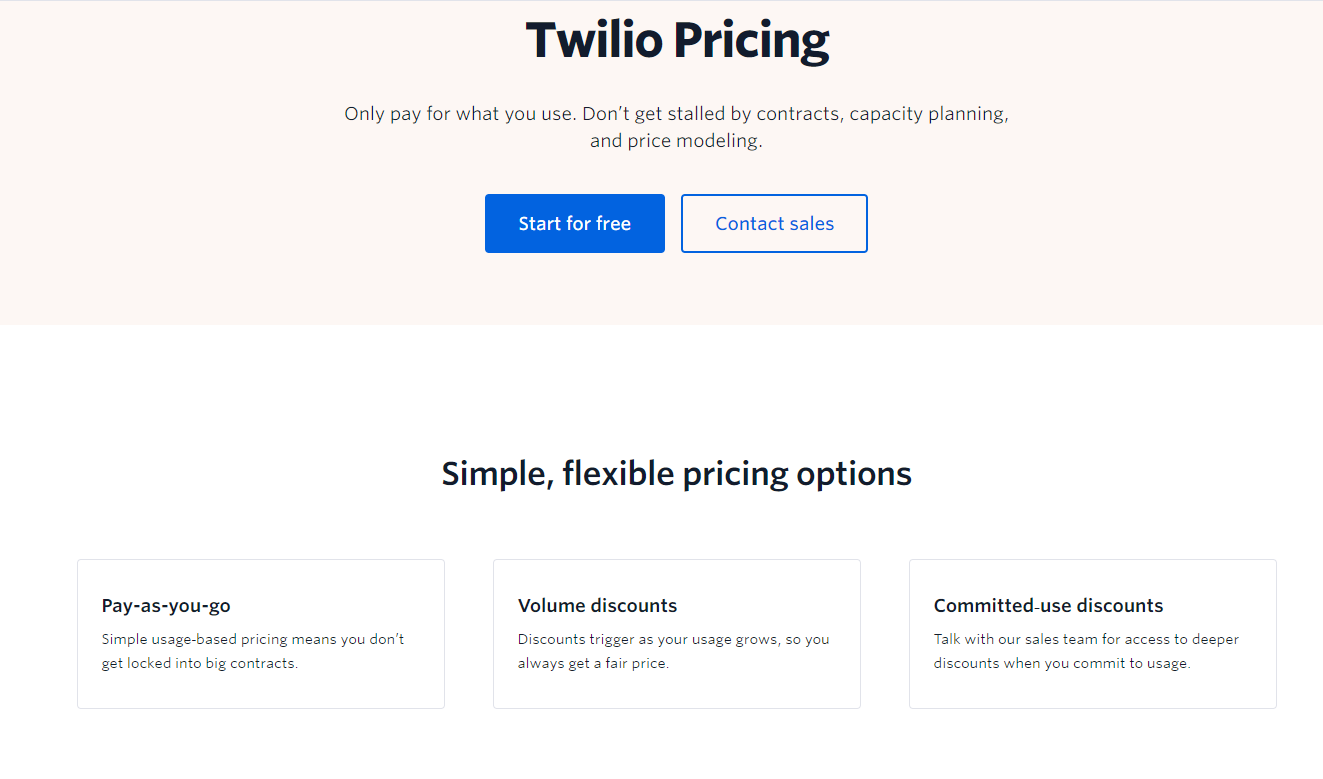
Twilio pricing is pay-as-you-go based on usage, without fixed monthly fees. Cost components include the number of messages sent/received, communication channels enabled (email, voice, chat, etc.), levels of customer support, and platform add-ons.
Free and entry tiers exist for small workloads. Volume discounts also apply for high-usage customers based on annual paid plan usage.
Overall, flexible scaling from individual developers to large enterprises based on live communication requirements. No wasting money on unused capacity with their usage-based model.
SendGrid
The SendGrid pricing tiers include a free plan for up to 2,000 contacts, and premium plans that range between $15 and $60/month.
Costs consider the number of contacts, emails sent, data retention duration, and number of dedicated IP addresses needed. Volume discounts were available for pre-paid annual plans and high-sending applications.
Overall, gaze pricing accommodates low to high email volume use cases through a tiered model. Minimum commits can contribute to waste if usage dips.
Winner: Twilio
The two companies offer immense value for money. However, Twilio’s pure pay-as-you-go model ensures optimal cost matching to usage without unused capacity spend. However, SendGrid’s tiers offer more upfront clarity into recurring costs at various usage levels.
Each model has pros/cons suited for different use cases. For fully dynamic workloads, Twilio pricing flexes best. But SendGrid tiers suit predictable forecasts. It’s ultimately too close to call definitively.
8. Reviews and Reputation
Twilio
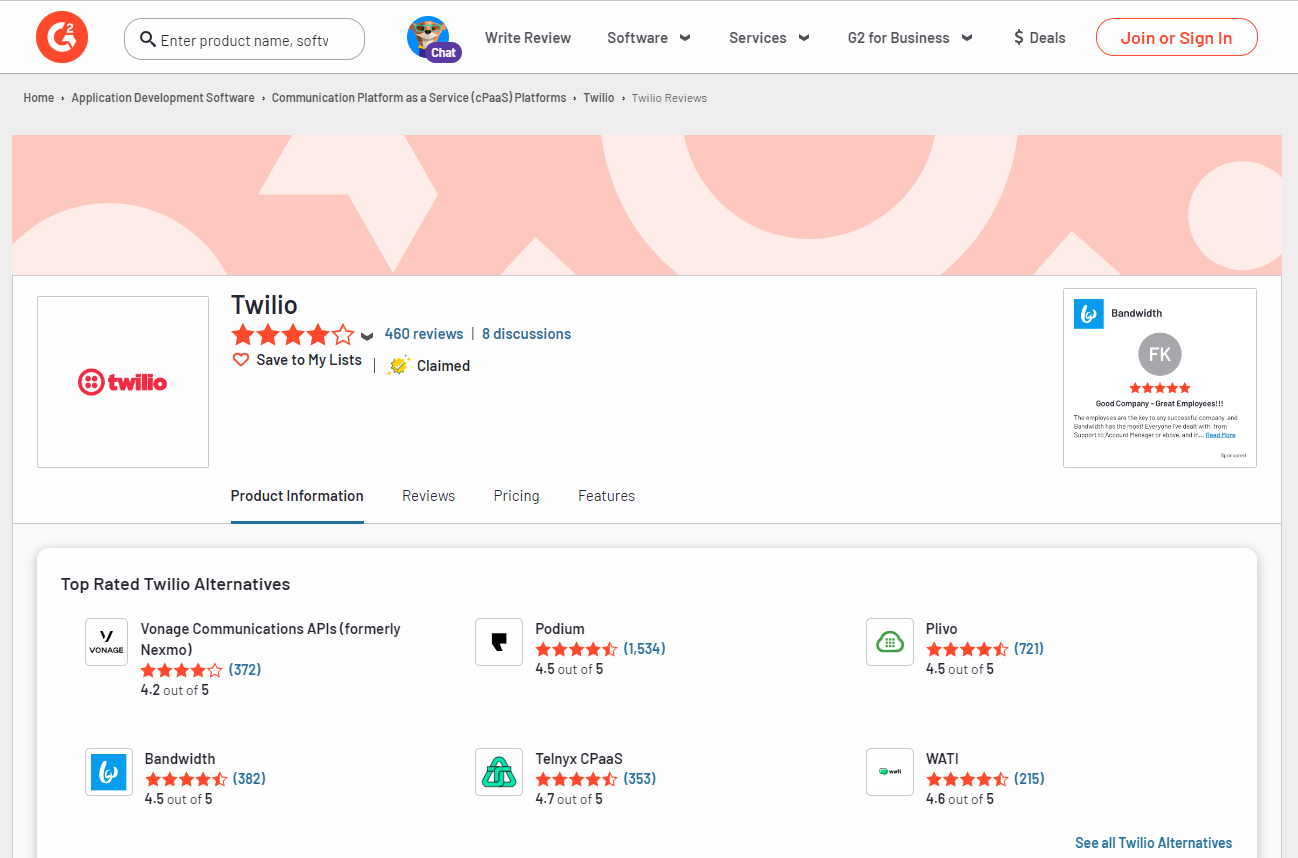
Looking at trusted review sites, Twilio earns outstanding feedback for its flexible unified communication platform, ease of integration, scalability, and support. Multiple users praise the ability to build custom solutions spanning voice, chat, video, and more using Twilio’s simple yet powerful APIs and pre-built tools that reduce deliverability issues for transactional emails.
As G2’s Leader in Communications Platform-as-a-Service, Twilio garners recognition for overall experience and quality compared to similar services. Average ratings exceed 4.4/5 across measures like ease of use, setup, admin experience, support, and documentation quality.
However, some note visibility into pricing and forecasting costs for dynamic workloads can improve. However, the vast majority positively rate Twilio’s offerings as suitable for a range of communication requirements.
SendGrid
As a long-recognized Leader in Email Marketing Software by G2, SendGrid earns strong recommendations as a dedicated email delivery platform managing high-volume transactional and marketing email reliably.
Positive notes from customers highlight the array of tools improving deliverability, flexible APIs, automation functionality, and quality analytics and reporting. Average user satisfaction ratings typically exceed 4.3/5.
Less favorable feedback indicated some gaps in platform scalability, contact segmentation capability, and complex pricing structure comprehension. But generally, SendGrid enjoys loyal support from email marketers valuing inbox placement and analytics.
Winner: Tie
Both Twilio and SendGrid earn impressive reputations and user sentiment leading their respective communication-focused niches. Twilio edges ahead for adaptable unified communications, while SendGrid takes email delivery and campaign facilitation capability specifically.
Each garners high marks in crucial areas like usability, support, and documentation making them equally sound choices based on review data.
9. FAQ’s
Twilio FAQs
- What types of communication can you manage with Twilio?
Twilio supports building voice, SMS, MMS, chat, video, and email communications via its cloud platform. - Is coding required to use Twilio?
No, Twilio offers a visual builder and pre-build add-ons allowing non-developers create to workflows. But developer APIs exist to build customized functionality. - How quickly can you get started with Twilio?
Twilio only takes minutes to set up with pay-as-you-go billing, letting you rapidly activate numbers and start building communication flows across channels. - Does Twilio integrate with popular business apps?
Yes, Twilio provides pre-build integrations, plugins, and APIs to connect communication data and workflows with platforms like Salesforce, Zendesk, and Slack. - Is Twilio secure for sensitive communications?
Yes, Twilio is certified to high-security standards like HIPAA with encryption, data access controls, and features to verify identities.
SendGrid FAQs
- What types of email can SendGrid deliver?
SendGrid focuses specifically on reliably sending high volumes of marketing and transactional email. - Does SendGrid offer email templates?
Yes, SendGrid provides lots of professionally designed email campaign templates across common categories and use cases to save time. - Can SendGrid improve email engagement?
SendGrid has dedicated tools for maximizing email deliverability, opens, and click-through rates powered by analytics. - Is SendGrid friendly for nontechnical users?
The platform is designed to be intuitive for self-service by non-developers, with drag-and-drop workflow builders requiring no coding. - How many emails can you send with SendGrid?
SendGrid supports sending email at any scale – from thousands to billions per month by adding more dedicated IP addresses and tools.
Final Thoughts
Choose Twilio if…
…you need a unified platform for communications across channels like SMS, voice, email, chat, etc. Twilio shines where orchestrating seamless, multi-channel customer engagements using APIs for flexibility is a priority.
Also best suited for startups expected to have variable workloads month-to-month, taking advantage of Twilio’s pay-as-you-go pricing. The breadth of integration options and pre-built add-ons make it easy to embed and expand communications functionality as needs evolve quickly.
Choose SendGrid if…
…email marketing and highly reliable transactional email delivery at scale is your primary need. SendGrid brings industry-leading inbox placement and tools to maximize email program performance.
Great for established businesses forecasting steadier email volumes that can utilize SendGrid’s tiered pricing plans effectively. The platform also suits teams wanting to enrich existing CRM and marketing workflows with email-specific functionality using purpose-built automation and analytics.
